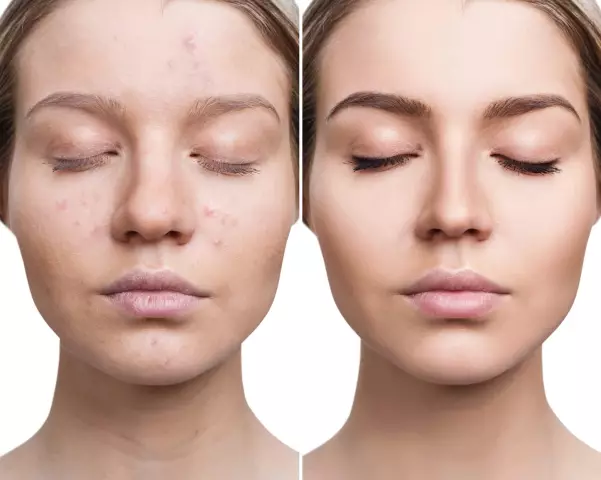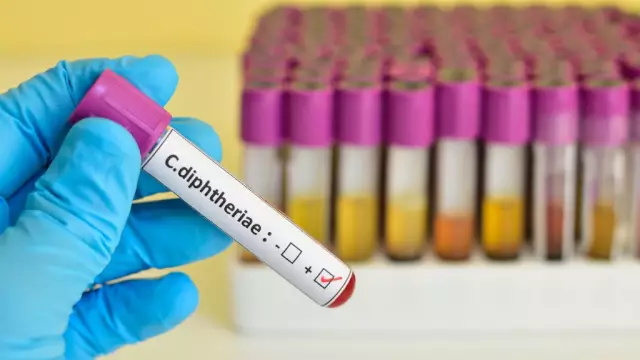- Author Rachel Wainwright [email protected].
- Public 2023-12-15 07:39.
- Last modified 2025-11-02 20:14.
Hyperesthesia
The content of the article:
- Causes
- Kinds
- Signs
- Diagnostics
- Treatment
- Prevention
- Consequences and complications
Hyperesthesia is a decrease in the threshold of sensitivity, leading to a sharp increase in the sensitivity of the sensory organs to the effects of ordinary in their strength, and sometimes indifferent stimuli. Hyperesthesia is not an independent disease; it is a symptom observed in a number of neurological and mental pathologies.

Hyperesthesia of teeth
Causes
There are many reasons for the development of hyperesthesia. The mental form of sensitivity disorders often lead to:
- withdrawal symptoms;
- asthenia;
- neuroses;
- manic-depressive states.
The causes of cutaneous hyperesthesia can be:
- mono- or polyneuropathy;
- diabetes;
- chronic renal failure;
- intoxication (organic solvents, heavy metal salts, plant poisons);
- scleroderma;
- vasculitis;
- extensive injuries of the skin (burns, abrasions).
Caries and thinning of the enamel layer near the neck lead to increased sensitivity of the teeth.
Kinds
Depending on the clinical manifestations, the following types of hyperesthesia are distinguished:
- mental;
- cutaneous;
- dental.
Signs
For mental hyperesthesia, a combination of emotional lability and increased nervous irritability is characteristic. Even a minor irritation, such as the ticking of a clock, is perceived by the patient as excessive, causing severe discomfort. This, in turn, entails the formation of emotional instability, which is manifested by conflict, tearfulness, intolerance, irritability.
With hyperesthesia of the skin, patients feel a burning and pressing pain in the affected area, reminiscent of pain from a thermal burn. Various physical factors (mechanical, temperature effects) can provoke the development of a pain attack. Hyperesthesia of the skin is often combined with pronounced dermographism (the appearance of bright red stripes on the skin under the influence of mechanical irritation).

Hyperesthesia of the skin manifests as pain similar to that of a thermal burn
Skin hyperesthesia is especially pronounced in patients with inflammation of the trigeminal nerve. Even, for example, a slight movement of facial muscles or a weak wind can cause an intense pain attack in them.
Hyperesthesia of the teeth is characterized by the occurrence of unpleasant sensations in the area of the tooth neck as a result of thermal or mechanical action.
Diagnostics
Diagnosis of hyperesthesia begins with a thorough history taking. In this case, the main goal is to identify the factor that caused the occurrence of hypersensitivity. The patient is examined by a neurologist and psychiatrist, and in case of dental hyperesthesia - by a dentist.

It is important to find out the cause of hyperesthesia.
To clarify the cause of cutaneous and mental hyperesthesia, a number of laboratory tests are shown, such as:
- general analysis of urine and blood;
- blood biochemistry with the determination of urea, creatinine, bilirubin, sugar;
- a blood test for the presence of heavy metal salts in the serum.
If a nerve injury is suspected, electroneuromyography is performed. This method makes it possible to assess the speed of conduction of an electrical impulse along a nerve fiber and thereby identify its possible damage.
Treatment
Treatment of hyperesthesia depends on the cause leading to the impaired perception of irritation. With the mental form of pathology, the following are shown:
- the appointment of antidepressants, hypnotics and adaptogens;
- organization of the daily routine;
- behavioral therapy;
- Spa treatment.
To reduce the severity of cutaneous hyperesthesia associated with diabetes mellitus, it is necessary to achieve normalization of blood glucose levels. If the cause of skin hypersensitivity lies in chronic renal failure and associated uremia, you need to revise the schedule of hemodialysis sessions. In case of poisoning with salts of heavy metals, detoxification is carried out.
In case of dental hyperesthesia, patients are advised to avoid too hot or cold drinks and dishes, and also regularly use special toothpastes that strengthen the enamel and thereby reduce the sensitivity of the teeth.

With hyperesthesia of the teeth, too hot and cold dishes are contraindicated
Prevention
Prevention of hyperesthesia includes the following measures:
- maintaining a healthy lifestyle;
- regular monitoring of blood pressure levels;
- timely treatment of kidney and urinary tract diseases;
- blood glucose control (with diabetes mellitus);
- an appeal to a psychologist or psychotherapist (in the event of stressful situations that the patient cannot cope with on his own).
Consequences and complications
With long-term hyperesthesia, a violation of labor and social adaptation occurs, a depressive state develops.
YouTube video related to the article:

Elena Minkina Doctor anesthesiologist-resuscitator About the author
Education: graduated from the Tashkent State Medical Institute, specializing in general medicine in 1991. Repeatedly passed refresher courses.
Work experience: anesthesiologist-resuscitator of the city maternity complex, resuscitator of the hemodialysis department.
The information is generalized and provided for informational purposes only. At the first sign of illness, see your doctor. Self-medication is hazardous to health!






